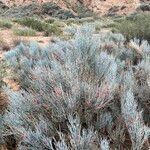A shrubby plant. It grows 50 cm high. It has many branches. The stems are green and the branches are opposite or in a ring. The leaves are thin and 2-4 mm long. Male and female flowers are on separate plants. The ripe fruit or cones are oval red berries. They are 5-6 mm long. There are 2-3 seeds.




